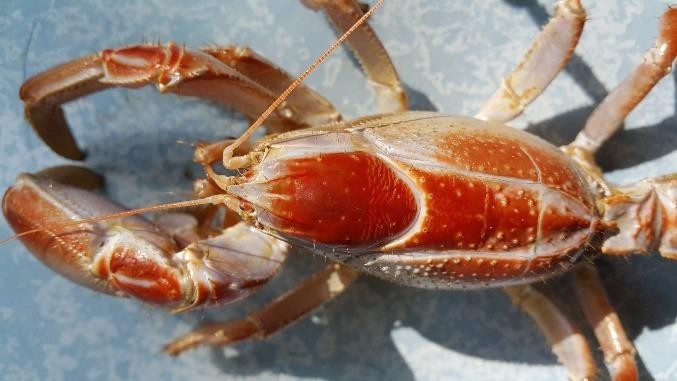This research group focuses on investigating biology of aquatic organisms and their relationships with environments to better inform scientific understanding and management of biodiversity. We work on aquatic organisms ranging from microbes to shellfishes and fishes, and aquatic ecosystems as diverse as freshwater, brackish water, coastal and terrestrial areas.
 Introduction:
Introduction:
Mud lobsters (Thalassina sp.) are nocturnal organisms belong to Order Decapoda. Mud lobsters are rarely seen due to their habitat which are far underneath the ground, but their existence is acknowledged by the presence of their mounds. Mud lobster is considered as an important organism in the mangrove ecosystem for its burrowing activities which helps in recycling nutrients and its nests which provide habitat for many mangrove organisms. In Sarawak, mud lobsters are consumed by the locals as a traditional remedy for asthma relief. The objectives of this project are to identify species of mud lobsters, its anti-inflammatory, antioxidant and antibacterial activities. This project was funded by Ministry of Higher Education Malaysia under the Fundamental Research Grant Scheme (Project No 07-01-15- 1760FR).
 Pictures:
Pictures:
 Mud lobster, Thalassina sp
Mud lobster, Thalassina sp
 Publication
Publication
 Journal
Journal
- Nur-Nadiah, Z., Malahubban, M., Fakurazi, S., Wong, S.C., Rajaee, A.H. (2019). Length- weight and morphometric analysis of mud lobster, Thalassina anomala from Sarawak, Malaysia. Pertanika Journal of Tropical Agricultural Science, 42 (1):209- 223.
Mud lobsters (Thalassina spp.) are nocturnal organisms, belong to Order Decapoda which are lesser known and least studied although their presence were widely distributed across the Indo-West Pacific Region. Mud lobster is considered as an important organism in the mangrove ecosystem for its burrowing activities and the role of its mounds or burrows as home to other animals. All mud lobster samples collected from four distinct regions in Sarawak (Kuala Tatau, Kuala Balingian, Sarikei and Lingga) were identified as Thalassina anomala based on the morphological characteristics. Morphometric variations between sexes of T. anomala were examined. Sexual dimorphism can be observed where males had significantly longer carapace length, left chelae propodus length and larger left chelae propodus width compared to females (p<0.05). Meanwhile, sexual dimorphism can also be seen in the abdominal width, in which it was significantly larger in females, for both absolute values (p<0.01) and also the relative values (p<0.001). The length-weight relationship of T. anomala were analysed between sexes by regression analysis. Results showed that males had isometric growth rate for carapace length-weight (CL/W), total length-weight (TL/W) and abdominal length-weight (ABL/W) relationships. However, females had negative allometric growth in CL/W and ABL/W relationship and isometric growth in TL/W relationship. Data from this study is able to provide baseline information which are useful for future reference on mud lobster resource management in Sarawak, Malaysia.
- Nor Hafishah, M.Z., Zakry Fitri, A.A., Rajaee, A.H., Malahubban, M. (2018). Antibacterial potential of methanolic and hexanic extracts of mud lobster (Thalassina anomala) from Bintulu, Sarawak, Malaysia. Research in Biotechnology, 9:1-4
Present study demonstrated the antibacterial potential of three different body parts, abdomen, carapace and cheliped of mud lobster (Thalassina anomala) which were extracted with methanol and hexane. Three test bacteria were used in this study namely Bacillus cereus, Escherichia coli, and Salmonella enterica. Present study found that in general, methanolic and hexane extracts of different body parts had variable inhibitory responses on different test bacteria with methanolic extract had greater inhibitory response than hexane extract. In methanol extraction, B. cereus significantly had greatest negative impact (p<0.05) on growth after treated with cheliped (21 mm zone of inhibition) extract of mud lobster as compared to carapace (9.2 mm) and abdominal (8.8 mm) extracts of mud lobster. Overall, the growth of S. enterica was much affected with the presence of all methanolic body-part extracts of mud lobster. In hexane extraction, B. cereus growth was not affected with all body-part extracts of mud lobster. However, E. coli and S. enterica were affected with no significantly different (p>0.05) among body-part extracts and between them. Present study concludes that the extracts of mud lobster of all body-part in methanol possess greater inhibitory effect on bacterial growth than extracts in hexane thus the methanolic extract of mud lobster has the potential to be exploited as a natural source of antibacterial agent.
 For more further enquiries:
For more further enquiries:
Dr. Amy Halimah Binti Rajaee
Senior Lecturer
Department of Animal Science and Fisheries
Faculty of Agricultural Science and Forestry
Tel: +6086 855832
Email:amyhalimah@upm.edu.my
Updated:: 07/09/2020 [lanz]
MEDIA SHARING











 Introduction:
Introduction: Pictures:
Pictures: Mud lobster, Thalassina sp
Mud lobster, Thalassina sp Publication
Publication Journal
Journal For more further enquiries:
For more further enquiries:


















